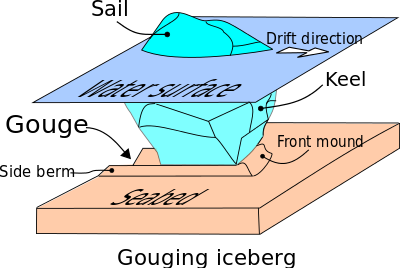

Seabed gouging by ice is a process that occurs when floating ice features (typically icebergs and sea ice ridges) drift into shallower areas and their keel comes into contact with the seabed.[1][2][3] As they keep drifting, they produce long, narrow furrows most often called gouges, or scours.[4][5][6] This phenomenon is common in offshore environments where ice is known to exist. Although it also occurs in rivers and lakes,[7][8] it appears to be better documented from oceans and sea expanses.[2][4][5]
Seabed scours produced via this mechanism should not be confused with strudel scours. These result from spring run-off water flowing onto the surface of a given sea ice expanse, which eventually drains away through cracks, seal breathing holes, etc. The resulting turbulence is strong enough to carve a depression into the seabed. Seabed scouring by ice should also be distinguished from another scouring mechanism: the erosion of the sediments around a structure due to water currents, a well known issue in ocean engineering and river hydraulics[9] – see bridge scour.